The other day I received a comment on the post “Call To Country” from Rachel, who asked;
Hi Gavin,
I wonder what your position is on nuclear power as an alternative energy source? I have always been opposed to it but studying my Masters in Sustainability has opened my eyes to lots of things including the myths around nuclear power. DecarboniseSA is an advocacy website (not run by me!) which does a lot to educate people regarding the true story of nuclear.
It was founded by one of my lecturers, a passionate environmentalist who has no connections to the nuclear companies but merely an objective and pragmatic approach to finding solutions. As much as I hate to admit it, we are not going to reduce carbon emissions by consuming less (as a society), so I think nuclear (with renewables) is one of our only options.
Rachel
Besides the harmful nuclear waste that the process leaves behind, the claim that nuclear power generation is CO2 free is simply a myth.
During my search to find proof, I stumbled upon this great post. I cannot claim the words in this post. They belong to Dave Kimble from http://www.peakoil.org.au/ and they are wise and well researched words as well.
Proponents of nuclear power always say that one of the big benefits of nuclear power is that it produces no or little Carbon dioxide (CO2).
This is completely untrue, as a moment’s consideration will demonstrate that fossil fuels, especially oil in the form of gasoline and diesel, are essential to every stage of the nuclear cycle, and CO2 is given off whenever these are used.
All of the material removed from this hole, over-burden and ore, was moved by truck.
| These trucks run on diesel. It would be interesting to know how much diesel is used for how much ore in a year at Ranger. If we are to increase the number of nuclear power stations, we also need to increase the number of these trucks (which obviously take a lot of fossil fuel energy to build), and the volume of diesel fuel. Currently Australia imports 50% of its diesel consumption, and this figure is rising as our oil production falls. The tyres on these trucks are also particularly energy-intensive to make, and there is a world-wide short of these tyres. |
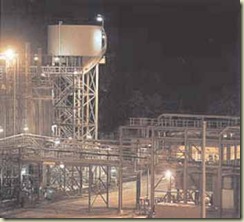 |
The depleted ore is washed and neutralised using lime, and the slurry is pumped to the tailings ponds. |
 |
Maintaining the tailings ponds, with more diesel powered machinery. |
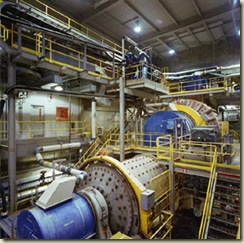 |
Hard rock ores, such as quartz conglomerates and granites, are approximately 3 to 4 times more energy-intensive than soft rock ores (limestones and shales) to crush. |
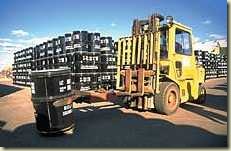 |
Drums of Uranium oxide are stacked by forklifts, while they await shipment, sometimes to the other side of the world. |
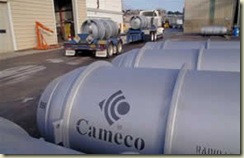 |
The Uranium hexafluoride gas is then transported in cylinders to be enriched. |
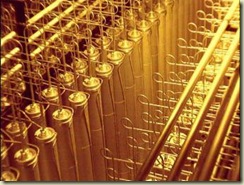 |
The standard enrichment process for pressurised water reactor (PWR) fuel converts this mix to: |
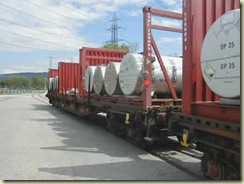 |
Low-enriched (3.6%) Uranium hexafluoride gas is then transported to the fuel fabrication plant. |
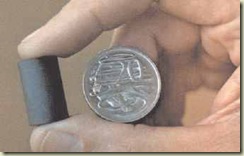 |
The UF6 gas is converted to Uranium dioxide (UO2) powder, pressed into pellets, and baked in an oil-fired furnace to form a ceramic material. These are then loaded into a tube made of a zirconium alloy. Several of these tubes form one fuel assembly. |
|
Zirconium is a metallic element derived from zircon, an ore of Zirconium silicate (ZrSiO4), which is a by-product of rutile sand mining (another energy-intensive business). Naturally occurring Zirconium is always found with Hafnium, which has to be removed (with difficulty) for nuclear uses. |
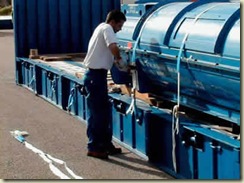 |
Fresh fuel is only mildly radioactive and can be handled without shielding. The fuel assemblies are then transported to the reactor by truck or train. A 1000 MW(e) nuclear reactor contains about 100 – 130 tonnes of Uranium dioxide, and usually one third of that is replaced in rotation each year. |
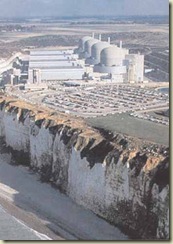 |
If you ignore the vehicles that the workers use to get to work, the reactor does not produce any CO2. But it does use electricity, as well as produce it, and to the extent that electricity is largely produced by fossil fuels, this needs to be counted in the energy balance. |
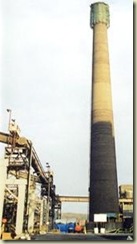 |
It takes a lot of steel to build a nuclear power station, and steel is made by smelting iron ore with coking coal. |
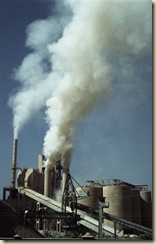 |
And a nuclear power station uses lots of concrete, which is made from cement. Cement is made by crushing limestone and roasting it, using fossil fuels, to drive off Carbon dioxide. So cement is particularly CO2-intensive. |
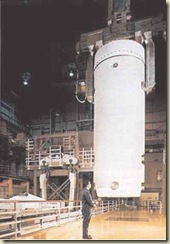 |
Spent fuel rods ‘normally’ spend six months in cooling ponds located within the reactor building, so that short-lived radio-activity can decay, making the material easier to handle. In the US and many other places, these spent fuel rods stay at the reactor a lot longer than that, while politicians argue over what to do with it next. |
| Reactor waste moved by road and rail. |
Spent fuel is kept under water until it is reprocessed. This keeps it cool and acts as a radiation shield. In the ‘once through’ process, the fuel rods are dissolved in acid, and the Plutonium is extracted, and the remainder including the Uranium becomes high-level waste. In the ‘recycling’ process, Uranium is also recovered.
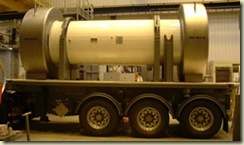 |
Recovered Plutonium and Mixtures of Plutonium and Uranium oxides (MOX) are sent by road back to the fuel fabrication facility to be used in new fuel rods. |
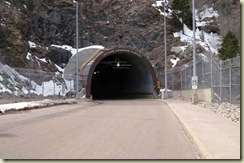 |
This is not really a waste repository, (it is the NORAD military bunker at Cheyenne Mountain) but this is what one might look like if one was ever to be built. |
 |
This is a security policeman, well , it does say POLICE on his bag. I do hope everything is alright. |
 |
Ah, that’s more like it. How many miles per gallon do you get out of one of those ? |
 |
Security surveillance is needed to prevent terrorists from getting access to radio-active materials. |
As you can see, every step of the nuclear power cycle involves the expenditure of energy derived from fossil fuels, which nuclear electricity cannot replace. Thus it is untrue to say that nuclear energy is greenhouse friendly.
In the paper “Nuclear Power : the energy balance” by J.W. Storm and P. Smith (2005) download here, the authors calculate that with high quality ores, the CO2 produced by the full nuclear life cycle is about one half to one third of an equivalent sized gas-fired power station.
| For low quality ores (less than 0.02% of U3O8 per tonne of ore), the CO2 produced by the full nuclear life cycle is EQUAL TO that produced by the equivalent gas-fired power station. |
So the question is :
Given that the greenhouse claims for nuclear power are false, and if the only way the nuclear industry can operate is with massive amounts of cheap fossil fuels, especially diesel derived from oil, and with oil going to be very much scarcer in the future, is this a good time to be thinking of increasing the nuclear industry ?
I think not!
Wise words indeed. Renewable energy is far less carbon intensive, doesn’t take years to come on line, and uses very little or no fossil fuels when operational (maintenance).
The best part is that renewable energy is beginning to take off in Australia now, and ramping up rapidly. We have more sunshine and wind that we could ever possibly used.
Why would we even consider Nuclear power at this stage of our energy transformation?


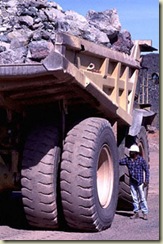
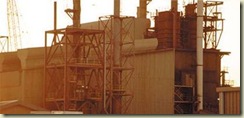
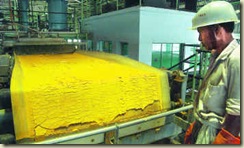
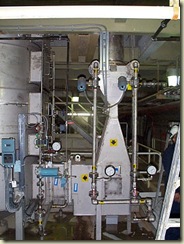
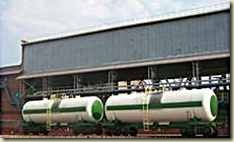



This is such a good explanation of nuclear power’s carbon emission life cycle. Thanks so much. I have sent it on to all of my friends.
Thanks Anon
Well if I’m not too late, can you send on my detailed response below? Your friends are now probably believing something that is false.
I’m not sure if my comment worked last night. Here goes again.
++
The case for nuclear as described here is argued as though renewables exist in a vacuum. As though they come into existence with a swipe of a magic wand along a ridge line. Of course they don’t. They too are susceptible to dirty mining, manufacturing and movement activities.
Don’t get me wrong, I am fully behind decking this place out with viable renewable energy. However, I don’t believe that this is a strong case against nuclear.
Your instinct was right. It isn’t a strong case at all. Please see my detailed response below.
One aspect of Nuclear Energy that is always over looked is the long term waste storage. Both the USA and Australia currently have NO long term storage plans for the 50 years of accumulated waste.
I’m not anti-nuclear energy, but until we have a long term solution to the waste, we are better off with renewables that are ready to go now.
Home Work; Get a quote for 12 months storage from your local warehousing/storage center. Now extrapolate that out to 1000 years, include inflation. Nuclear is not cheap.
Damo,
A couple of points.
Firstly, the technology to recycle 99% of that waste for more power is well in hand, and it is now just a matter of commercialisation. Please read this piece of mine. http://theconversation.com/safe-zero-carbon-and-proven-is-fourth-generation-nuclear-the-energy-solution-4204
Secondly, in simply nothing humans ever do, ever, do we create the expectation of needing an answer that extends 1,000 years into the future. Can you imagine people in the year 1013 worrying about us??? The very concept is ludicrous. The people of 1013 would not have been able to even conceptualise the world we live in today. The next 1,000 years? How could we possibly presume to prejudge either the needs or the capabilities of people in 1,000 years time, and use that to bias against a smart decision today? Try the seven generations approach http://decarbonisesa.com/2013/03/20/the-wisdom-of-the-seven-generations-approach/
No costings?
I didn’t not say we don’t have the technology to treat or storage nuclear waste, hell shoot it into the sun if you want. Just whats the cost.
I find your second point appalling. Its the reason we find ourselves in such a mess today. Surely we must always think of the consequences of our actions. Isn’t the alternative Anarchy?
So did you do your homework? Whats the cost Ben?
Damo,
I do a lot of costing work for my clients on all sorts of sustainability decisions. Nothing is ever, ever costed for 1,000 years. Not a road, not a bridge, nothing. It is a completely non-sensical notion, because after a certain amount of forecasting the assumptions you need to make are nothing more than sheer guesswork. But, as it happens, the recycling of this waste will have no cost, it will be profitable. People will pay the operators to take it off their hands, and the operators will then sell electricity from reactors that are considerably simpler in their design and operation that currently commercial reactors.
The second point is not “appalling”. it’s reality. Everything is always a trade off of some type. Pretending otherwise is just often used as an excuse to avoid consideration of relative risks. Right now, by using 1,000 years as an excuse to not use nuclear, we are hastening a climate catastrophe that will be with us in 100 years. We know, don’t think, know that we can manage the waste for 100 years. Then we can let people make a new decision in 100 years time, hopefully from the stronger position of a stable climate. That IS thinking of the consequences of our actions. Consequences run both ways. If we use nuclear, there is a consequence. If we don’t, there is a consequence. The decision-maker’s challenge is to decide which path is best. No decision is a decision for the status quo, and the status quo is fossil fuels. I have 100% confidence that my grandkids will be able to handle spent fuel, it’s pretty simple in 2013. A runaway climate? They will not thank me for that.
In other words its too expensive to cost, Thanks Ben.
This comment has been removed by a blog administrator.
Just ask Japan what they think! Lol
I personally do not believe nuclear is the way to go, however that is what is being talked about in universities, in rather glowing terms, according to two of my sons who are currently studying, different courses. 🙁
Hello Gavin,
When I was growing up my dad worked for General Electric in their nuclear power division. He was a machinist with a knack for building and inventing things. I probably had a better grasp than most 14 year olds how nuclear power worked, but I did not give a thought to how much energy was required to get it to the point where is was usable.
Thanks for the interesting, informative post, Gavin. I think the waste storage issue and the accidental damage (think Japan) problems have not been sufficiently dealt with, and they probably will never be.
I all for cleaner sources such as solar and wind 🙂
Anyone in Australia who supports nuclear needs to have a good read of this: http://www.tai.org.au/documents/downloads/WP96.pdf
It’s an unbiased report explaining where nuclear power stations could be situated. And remember, Australia can’t just build one nuclear power station. We’d need at least 10 or so to make it “economically feasible”. John Howard’s nuclear power study proposed 12-25 reactors.
From the link above:
“The selected sites are:
– in Queensland: Townsville, Mackay, Rockhampton, Gladstone, Bundaberg, Sunshine Coast and Bribie Island;
– in NSW and the ACT: Port Stephens, Central Coast, Botany Bay, Port Kembla and Jervis Bay/Sussex Inlet;
– in Victoria: South Gippsland, Western Port, Port Phillip and Portland; and
– in South Australia: Mt Gambier/Millicent, Port Adelaide and Port
Augusta/Port Pirie.”
So there’d be a nuclear reactor within an hour or two’s drive of 90% of the Australian population! How do you think that’d go down?
Wow. Scary.
Ever been to France?
Yep, very Scary for the siting MP’s.
Do you think any of them will include it in the election campaign come September?
Scary for MPs when people go out of their way to run gratuitous fear campaigns.
How about trying to get a sensible option on the table for national discussion first, rather than trying to prevent sensible discussion from occurring in the first place by going out of your way to freak people out??? This type of thing is lousy in the same way as when people try to freak out communities about wind turbines, which has led to stupid planning laws in places like Victoria.
Personally, I don’t think we have the time to build nuclear power plants anyway. It’d take us at least 10 years (not including the political wrangling, planning studies, and public protests) to get the first one up and running, plus we’d be staggering construction of at least 9 others during the same period.
The capital cost would be many, many billions of dollars (and the final costs will be at least double the original estimates, as shown by almost every other reactor project in the world).
Who could tie up that much money for that long, with no returns for over a decade? There’d be huge risks arising from the extended time period – interest rate rises, inflation, exchange rates, policy changes, law changes, public sentiment changes, not to mention peak oil effects and the slowly crumbling international economy.
I really don’t think you could find anyone to back such a project. And I really don’t think it would be completed – something along the way will derail it.
Far better to spend that money on developing renewables and reducing demand. We use way more energy than we really need to!
A 2011 study claimed that “peak uranium” is only decades off anyway (maybe as long as 70 years, probably less). Nuclear power projects started today may not even be able to keep running for their design life due to lack of fuel (or at least rising fuel costs).
When the UK tried to privatise its nuclear plants, they were so unprofitable that they could only be given away. That says a lot about the economics of nuclear power! Out of interest, the company that acquired them (British Energy) had to be bailed out by the government 8 years later, to the tune of 3.4 billion pounds.
At a recent TED talk here in the states a couple of students from MIT put forth a new idea for Nuclear Power. Based on an old idea from the 50’s and 60’s they suggest using the spent fuel from current reactors to power their new reactor. By their estimates, they would be able to take the current stockpile of spent fuel and use it more efficiently. Reducing the radioactivity to levels of only a few hundred years instead of hundreds of thousands of years. Here’s a link to the clip from the TED talk. Might be a better solution and reduce the carbon footprint of current reactors.
Steve
http://www.youtube.com/watch?v=AAFWeIp8JT0
Steven,
The idea is better developed than you realise. The UK Government is being actively petitioned by GE-Hitachi to let them build a reactor call a PRISM to do exactly this with stockpiled separated plutonium. This system, called the Integral Fast Reactor (when paired with the recycling facility), was completed in 1994. It was be discussed in detail in a film this year called Pandora’s Promise. I have written about this in some detail here http://theconversation.com/safe-zero-carbon-and-proven-is-fourth-generation-nuclear-the-energy-solution-4204
GE-Hitachi just got hit with a $2.7 million penalty for fraud and for gouging the public purse with false claims. http://www.justice.gov/opa/pr/2014/January/14-civ-069.html
I agree with everything you wrote about the dependency of Nuclear power on fossil fuels, but I would go one step further and say, it also applies to Renewables. True, the energy capture is free with renewables (if you’re only measuring that component) but the manufacturing of components and delivery system is not.
Renewables try to get as much mileage from their free energy production as possible, which unfortunately (like all things “free”) doesn’t last very long. They need a fossil fuel host to plug themselves into, in order to carry them the rest of the way. Which is fine, I just disagree with the implied message that less destructive emissions equals less emissions in total.
What’s more, it continues the belief there is an energy source mankind can use, which does not require fossil fuels. Renewables aren’t that energy source, just like you outlined, Nuclear power is not. There will always be a debate between different energy sources, that really should take place in the interests of public education. But it’s the total capacity for destruction we should be paying closer attention to – because that accumulative effect has been interfering with the planet’s natural systems.
I don’t believe any of the individual parties in the energy industry (even householders) want to take responsibility for that. And that’s really the problem. Everyone wants what they feel they deserve, and only give away their excess. With everyone operating with a sense of entitlement, nothing will change in how we manage our energy consumption. The total output will still be excess to demand, so there’s room made for more to want.
It never seems to go the other way, does it? I’m not blaming you for that, I’m just making the point that it seems to be the trend.
Gavin,
Electricity generated from a nuclear power plant is roughly equivalent (10-110 g CO2-e, best estimate 60g) in lifecycle emissions as wind (13-40, best estimate 21). Both wind and nuclear are superior to solar PV (53-217, best estimate 56). Critically all three are vastly superior to coal (843-1171 for black, best estimate 941) and gas (491-655 for combined cycle, best estimate 577).
In reaching you conclusion, you have drawn on a single study that is known to be a substantial outlier in the global literature. Furthermore, this study has not been published in a peer reviewed journal.
The University of Sydney reviewed 39 studies that addressed this issue. Of those 39:
• 37 concluded that nuclear was less than 50 g per kWh
• 2 reached a conclusion of 50-100 g per kWh
• 1 determined that it was between 100 and 200 g per kWh
That single outlier is Storm, Van Leuwen and Smith, the single study you have cited. Looking at the study myself from the link you provided it would appear their best estimate is about 125g /kWh (chart at the top of page 41).
Even as a serious outlier in the literature, this is estimate is not even close to the emissions of coal or gas fired generation. Even looking at the source, I am struggling to see how you have reached your conclusion that nuclear emissions are one half, one third or even equivalent to gas fired generation. Taking this worst possible, non-peer reviewed outlier case for nuclear of about 125g, and the lowest end of the range for combined cycle gas (491), nuclear is just shy of 4 times superior to gas across the lifecyle, and still better than solar PV!
There are extensive critiques of this study. I will just offer something obvious of their assumed life of a nuclear plant of only 30 years. A plant built today will be rated for 60 years, and there is plenty of real world experience to back that up. On that basis alone, we can halve their estimate.
Respectfully Gavin, we need to occupy the mindset of an analyst for a long time before settling on opinions and jumping into the Activist role. Your analysis here is dangerously bad, as it will see people opposing an essential solution to climate change.
I request you provide a revised response to the question from Rachel. Your blog seems to be well-read. I have no idea about the rest, but on this occasion you are promoting complete nonsense.
Key reference here http://www.isa.org.usyd.edu.au/publications/documents/ISA_Nuclear_Report.pdf
An ammedment to my own post. In doubling the lifespan, we can only halve the contribution of some aspects of the estimated lifecycle emissions from the study. The new fuel will bring new lifecycle emissions.
Another ammendment: I note that the analysis does not belong to Gavin, but has been borrowed. All the better! What do you think Gavin? Is your position worth revisiting on at least this aspect of the question of nuclear?
Just found this article. Yes, I wrote “Does nuclear energy produce no CO2?” which is now at
http://www.davekimble.org.au/peakoil/news/index.php?does_nuclear_energy_produce_no_co2.htm
and it only tries to answer that question, not the larger question of whether nuclear is a good energy solution.
It is true that ALL alternatives to fossil fuels can only exist when embedded within a fossil fuel economy. While CO2 is an important problem, it is not as urgent as the fundamental problem of the scarcity of energy due to Peak Oil, soon to be followed by Peak Gas and Peak Coal.
Peak Oil started to bite in 2004, when it became impossible to raise oil production rates in line with the previous 20 year average of 1.6% growth per year. When demand outstrips supply, the price goes up, and not just linearly as this is a free-market auction system. So we saw the oil price leave the US$22 – 28 bracket in December 2003, and by mid-2008 it touched US$147 /barrel. This, along with other factors, caused the global financial crisis with its economic recession and collapse of demand for oil. We are now stuck with a stagnant world economy with oil at around US$100 /b, and if things were to improve, the cost of oil would rise again, causing another crash.
So the problem is really the scarcity of energy, and the choice of alternatives to fossil fuels has to be looked at in this light. The future is not going to be like the past, when all problems could be solved by “building new stuff”. Now we have to consider whether we have the spare energy to run the world AND build the new stuff to make more energy in the future.
Sadly our governments are still in denial about Peak Oil, as they don’t want to upset the major oil companies, whose share price would plummet if it became clear that the oil boom was over. So we have economies barely surviving even with Quantitative Easing and zero interest rates. We have a shale oil and gas bubble happening in the US, entirely financed with free “funny money” and unable to survive under conditions of normal interest rates and manageable prices.
If you look at how much energy it takes to build the infrastructure for each alternative energy source, and what that would do to the price of energy and the cost of doing business, you will find that THERE IS NO SOLUTION. The only conclusion is that Peak Oil implies Peak Energy, and that implies Peak Industrial Civilisation. From here on, we will see more austerity and inability to generate economic growth, until the point is reached when the whole thing implodes and chaos rules.
There’s lots more to be said on this, of course, but any solution that starts with “We must build more …” is doomed to failure, and “We must build LESS …” is the way to go.